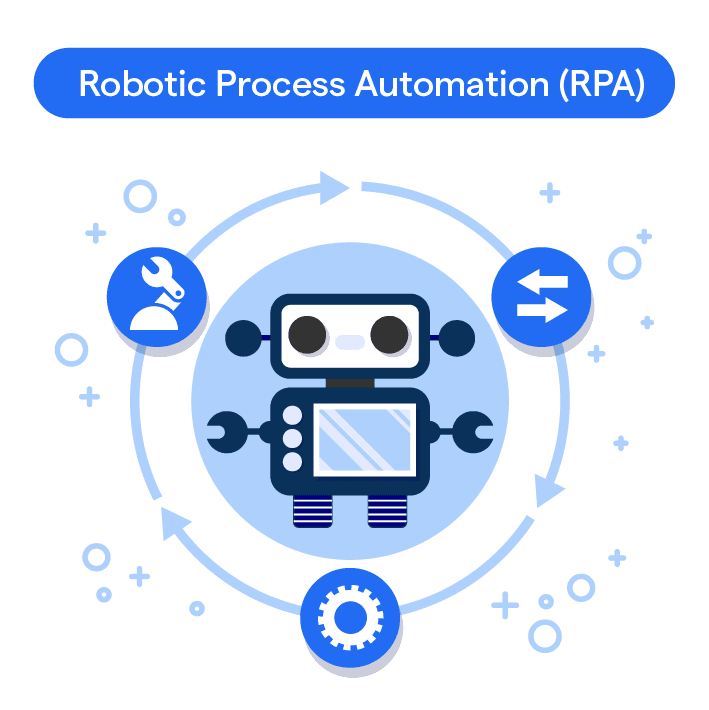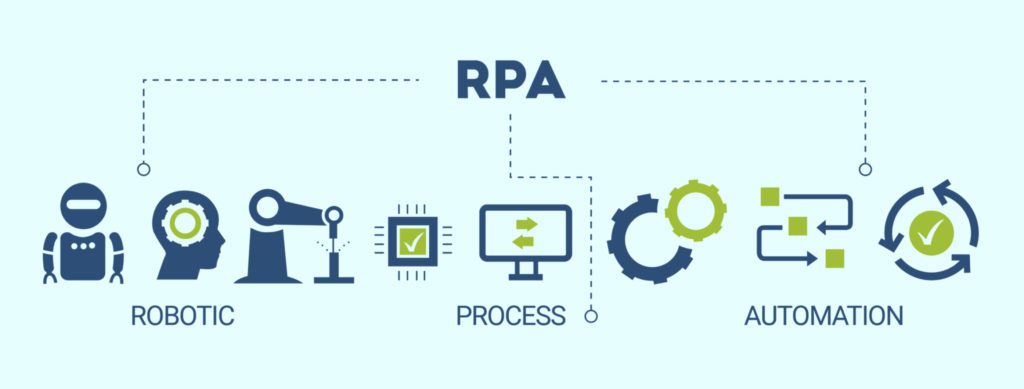5 Ways RPA is Uplifting and Unleashing IT Industries Potential
5 Ways RPA is Uplifting and Unleashing IT Industries Potential
RPA Introduction:
It is vital to stay ahead of the curve in the continuously changing sector of information technology (IT). Every discovery and development brings the promise of increased efficiency, production, and a competitive edge. Of all the technologies clamouring for our attention, Robotic Process Automation is the one that genuinely alters the game.
RPA is a revolutionary force that is changing the basics of how IT businesses operate, not just another buzzword in the IT world. RPA frees IT professionals from the restrictions of normal tasks by automating repetitive, rule-based operations. This frees them up to concentrate on strategic projects that spur innovation and corporate success.
In this blog article, we’ll look at five ways that is boosting and unlocking the IT industry’s potential. It is transforming IT operations by reducing procedures, expediting software development, strengthening cybersecurity, optimising infrastructure management, and improving customer service.
The persistent search of efficiency and agility has defined the evolution of information technology. With RPA, IT organisations are not only keeping up with this progress, but driving it ahead at an unprecedented rate. By using the power of automation, IT workers can accomplish previously inconceivable tasks, ushering in a new era of innovation and development.
Join us as we explore the game-changing implications of robotic process automation and how this new technology is altering the face of the IT business. The promise of robotic process automation is clear for both small and large businesses, offering unparalleled success, production, and efficiency in the digital age.

Enhanced Efficiency
In the field of information technology (IT), robotic process automation is a shining example of efficiency that is radically changing how IT tasks are carried out. Fundamentally, it improves IT operations by automating time-consuming, repetitive procedures that have historically consumed resources and reduced productivity. It provides the highest efficiency for IT operations, which comprise a wide range of services such as software deployment, system monitoring, and data management.
RPA automates all stages of the software deployment process, from code compilation to deployment across many environments, removing the need for human intervention. In addition to speeding up the deployment process, this ensures correctness and consistency while reducing the potential of mistakes that are commonly associated with manual deployment procedures. Similarly, RPA bots may be trained to continuously monitor system performance indicators, immediately warn IT workers of any irregularities or potential problems, and, in certain cases, conduct corrective action on their own.
Furthermore, It may automate data entry, validation, and processing in data management operations, reducing the time and effort required for data-related tasks. It frees IT personnel from the restrictions of repetitive labour by automating these routine tasks, allowing them to concentrate their time and resources to more strategic objectives.
It relieves IT personnel of manual job responsibilities, allowing them to focus on more valuable tasks such as innovation, issue solving, and strategic planning. IT professionals may use their abilities to enhance business innovation, solve complex technical challenges, and build strategic initiatives that benefit the organisation by assigning regular tasks to bots.
Primarily serves as a catalyst for higher efficiency in the IT industry, allowing businesses to optimise the capabilities of their IT workforce, streamline processes, and generate productivity gains.
Accelerated Software Development
Robotic process automation is revolutionising the software development lifecycle, accelerating everything from deployment to code testing.It reduces software product time-to-market and increases efficiency by automating these activities.
Code testing is one of the primary areas where it has a significant impact. Conventional software testing is prone to human error and takes a long time. Testing may be conducted more quickly and precisely by automating the execution of test cases with technology. It bots may also automatically detect and report faults, reducing the need for human intervention and accelerating the debugging process.
Furthermore, RPA is critical to the software development process and deployment. The complexity and duration of manual deployment methods usually cause delays in the introduction of new features and updates. Systems automate software application packaging, deployment, and configuration, hence simplifying deployment operations. This reduces the likelihood of deployment issues and saves time by maintaining consistency across several settings.
It also makes it simpler to build pipelines for continuous integration and continuous deployment, or CI/CD, which are critical components of agile software development approaches. Bots may automate software update deployment, testing, and code adjustments. As a result, development teams may offer updates or fixes more often, accelerating iterations and improving response to client requests.

Consider a scenario in which a web application’s CI/CD pipeline includes a bot. The bot automatically deploys the programme to production environments, runs automated tests, and retrieves code changes from version control. This seamless automation of the development and deployment process results in shorter release cycles and a faster time-to-market for new features.
To summarise, it accelerates software development by automating tasks such as deployment, issue resolution, and code testing. Using it’s technologies in CI/CD pipelines may help organisations achieve faster iterations, reduce time-to-market, and preserve a competitive advantage in today’s fast-paced digital environment.
Last but not least, the MERN stack includes a vibrant community that offers a diverse set of libraries, frameworks, and tools. Developers may use this community to solve issues faster, exchange ideas, and create faster by leveraging best practices and reusable components.
Improved Cybersecurity
In the world of cybersecurity, robotic process automation (RPA) is proving to be a valuable friend, giving innovative approaches to combat ever-changing digital threats. RPA is critical for boosting an organization’s overall security measures since it automates several cybersecurity jobs.
Threat detection is one of RPA’s primary contributions to cybersecurity. RPA systems can monitor user behaviour, system records, and network traffic for anomalous activities that may indicate an oncoming cyberattack. RPA bots can quickly assess massive amounts of data using machine learning techniques, allowing them to detect security vulnerabilities before they become significant breaches.
RPA improves the efficiency of incident response operations in addition to detecting risks. RPA bots can be programmed to automatically perform specified reaction actions in the case of a security breach. This requires conducting forensic investigations, blocking malicious IP addresses, and isolating affected systems. RPA significantly reduces response times by automating these activities, reducing the impact of security incidents on organisational operations.
Furthermore, RPA reduces the likelihood of human error in cybersecurity operations, which is typically a significant vulnerability. Under pressure, human operators may accidentally overlook critical security alarms or break established regulations. RPA bots, on the other hand, ensure the accurate and consistent execution of security activities by strictly following to specified rules and protocols. This reduces the probability of humans mistake while simultaneously improving the efficiency and reliability of cybersecurity operations.
Overall, RPA is critical for improving an organization’s cybersecurity posture since it automates security policy enforcement, incident response, and threat detection. Using RPA technology, organisations may strengthen their cyberattack defences, decrease risks, and preserve private information and assets in an increasingly hostile digital context.
Enhanced Customer Support
Robotic process automation is transforming the IT industry’s customer care by providing quick and easy solutions to common problems. RPA excels at simplifying IT support operations. RPA significantly improves the performance of support teams by automating issue triage, resolution, and customer communication.
Historically, IT helpdesk operations employed manual ticket management, which required support professionals to devote substantial time to sorting and allocating cases. However, automated ticket triaging with RPA makes this process more efficient. Without the need for human contact, RPA bots may review incoming tickets, classify them based on specified criteria such as urgency and complexity, and route them to the appropriate support staff members. This minimises the time spent on administrative activities and ensures that key issues are addressed promptly.
Additionally, RPA is critical to the automation of ticket resolution. RPA bots can handle common IT issues on their own since they have pre-defined procedures and decision-making abilities. Support agents may focus on more complex problems that require human intervention by automating routine tasks such as software installations, system updates, and password resets. Resolution times are greatly reduced, increasing customer satisfaction.
RPA bots excel in customer service because they reply to queries and assistance requests promptly. These chatbots can understand and respond to natural language questions, walk users through troubleshooting steps, and provide relevant data or answers quickly. RPA bots ensure a faultless customer support experience by delivering rapid assistance 24/7, regardless of time or day.
Furthermore, Node.js simplifies the integration of third-party services into MERN stack applications by easing the process of adding libraries and APIs. Node.js makes it easier to integrate with payment gateways, social networking platforms, and data analytics tools, allowing developers to simply increase the functionality of their apps.
In summary, the integration of RPA in customer support operations transforms the IT industry by streamlining helpdesk operations, automating ticket resolution, and responding quickly to client inquiries. IT organisations may use RPA technology to increase customer happiness, reduce response times, and maximise resource utilisation, all of which contribute to their company’s success.
Optimised Infrastructure Management
Robotic Process Automation (RPA) is altering IT firms’ infrastructure management methods by automating tasks such as cloud resource allocation, network configuration, and server provisioning. RPA allows you to execute arduous, repetitive tasks that were previously done by hand swiftly and precisely. This improves operating efficiency and optimises the utilisation of existing resources.
One of the key advantages of RPA for infrastructure management is its ability to reduce downtime. RPA automates routine maintenance tasks and proactive system monitoring, assisting in discovering and fixing mistakes before they escalate into more significant difficulties. By taking a proactive approach to infrastructure management, the chance of downtime is reduced, and end users receive uninterrupted and available IT services.
Strong data validation and sanitization methods are critical for ensuring data security and integrity. This includes sanitising inputs to decrease security risks and validating user input to prevent malicious data injections. Following recommended practices for data validation will help you keep your database clean and safe while also preventing against typical risks.
Furthermore, RPA is critical for improving resource utilisation in IT infrastructure operations. RPA bots may dynamically allocate resources depending on demand by assessing data and trends. This guarantees that computer resources are used efficiently and not overprovisioned or underutilised. This optimisation improves speed while simultaneously lowering expenses by eliminating unnecessary expenditure on additional resources.
Furthermore, RPA enables IT infrastructure operations to be expanded by automating the process of modifying resource levels in response to changing workloads. RPA provides an adaptive and agile solution that can alter to meet the changing demands of the company, such as scaling servers to manage increased website traffic or updating cloud resource allocations to meet shifting business needs.
To summarise, RPA is a useful approach for enhancing infrastructure management in IT organisations. RPA improves resource utilisation, maintains scalability in IT infrastructure operations, and decreases downtime by automating tasks like as server provisioning, network configuration, and cloud resource allocation. IT firms may operate more effectively, competitively, and efficiently in today’s fast-paced business environment by utilising RPA in infrastructure management.
Conclusion
Finally, the advent of Robotic Process Automation (RPA) has resulted in a considerable revolution in the information technology (IT) sector. It is more than a buzzword; it is a revolutionary force that is fundamentally altering the way IT businesses function. Using RPA may provide organisations with a plethora of benefits that apply to all elements of their organisation.
One of the most significant advantages of RPA is its ability to boost IT process efficiency. RPA automates repetitive activities and workflows, freeing up vital time and resources for IT staff to dedicate to more strategic and creative pursuits. This not only speeds operations, but also develops an organisational culture of continual development and adaptability.
Furthermore, RPA is critical for speeding up software development cycles. RPA enables IT firms to develop high-quality software products faster and more efficiently by automating operations such as deployment, bug fixes, and code testing. This enhances the organization’s competitiveness and adaptability to the ever-changing demands of stakeholders and consumers.
Furthermore, RPA contributes significantly to the improvement of cybersecurity standards in IT firms. RPA helps businesses reduce risk and safeguard sensitive data and assets from cyber assaults by automating threat detection, incident response, and security policy enforcement. This proactive approach to cybersecurity fosters confidence among partners and customers while also increasing the organization’s resilience.

Furthermore, RPA helps to optimise infrastructure management operations including cloud resource allocation, network configuration, and server provisioning. RPA ensures the best use of resources, decreases downtime, and provides for scalability, allowing IT organisations to manage their IT infrastructure more efficiently and adapt to changing business demands.
To summarise, using RPA may help IT organisations retain their competitiveness, creativity, and agility in a rapidly changing digital world. Organisations who seize the opportunity to adopt this revolutionary technology into their operations as RPA’s potential grows will benefit immensely and drive long-term success in the digital era.

